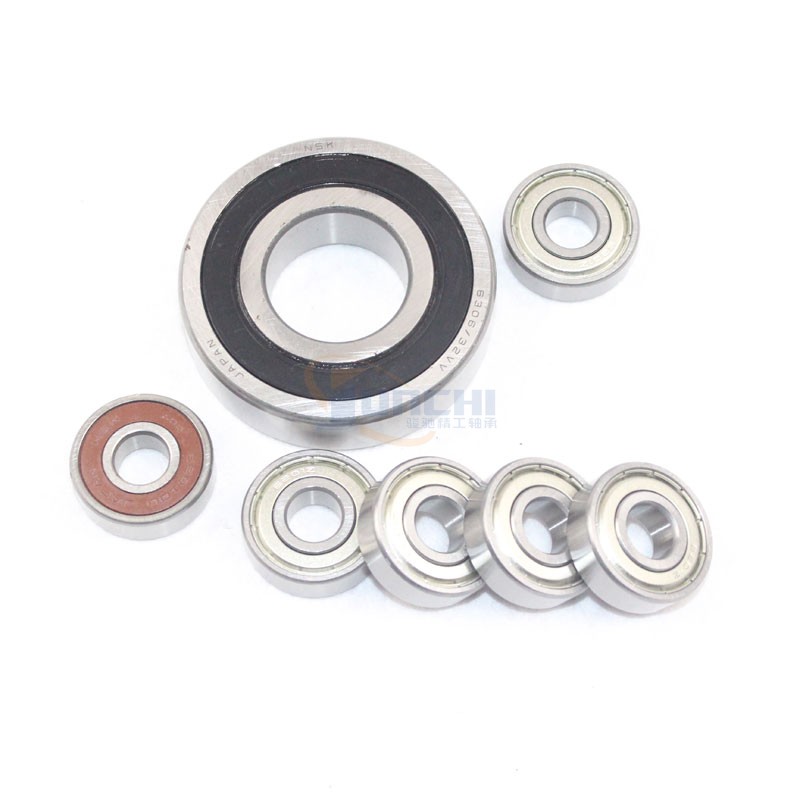軸承中振動的產生一般來說,滾動軸承本身不產生噪音。通常感覺到的“軸承噪音”事實上是軸承直接或間接地與周圍結構產生振動的聲音效應。這就是為什么許多時候噪音問題可被視為涉及到整個軸承應用的振動問題。
Generally speaking, rolling bearings do not produce noise themselves. The usual "bearing noise" is in fact the sound effect of bearing vibration directly or indirectly with the surrounding structure. This is why many times noise problems can be regarded as vibration problems involving the whole bearing application.

?。?)因加載滾動體數量變化而產生的激振:當一個徑向負荷加載于某個軸承時,其承載負荷的滾動體數量在運行中會稍有變化,這引起了負荷方向的偏移。由此產生的振動是不可避免的,但可通過軸向預加載來減輕,加載于所有滾動體(不適用于圓柱滾子軸承)。
(1) The excitation caused by the change of the number of loaded rollers: when a radial load is loaded on a bearing, the number of loaded rollers changes slightly during operation, which leads to the deviation of load direction. The resulting vibration is unavoidable, but can be reduced by axial preloading on all rollers (not applicable to cylindrical roller bearings).
?。?)局部損壞: 由于操作或安裝錯誤,小部分軸承滾道和滾動體可能會受損。在運行中,滾過受損的軸承部件會產生特定的振動頻率。振動頻率分析可識別出受損的軸承部件。此原理已被應用在狀態監測設備,用來探測軸承損壞狀況。如要計算軸承頻率, 請參看計算程序“軸承頻率”。
(2) Local damage: due to operation or installation errors, a small number of bearing raceways and rolling elements may be damaged. During running, rolling over damaged bearing parts produces a specific vibration frequency. Vibration frequency analysis can identify damaged bearing parts. This principle has been applied to condition monitoring equipment to detect bearing damage. If you want to calculate the bearing frequency, please refer to the calculation procedure "bearing frequency".
?。?)相關部件的精度:在軸承圈與軸承座或傳動軸之間密配合的情況下,軸承圈有可能與相鄰部件的外形相配合而變形。如果出現變形,在運行中便可能產生振動。
(3) Precision of the relevant parts: In the case of close coordination between the bearing ring and the bearing seat or the drive shaft, the bearing ring may be deformed by matching the shape of the adjacent parts. If deformation occurs, vibration may occur during operation.
?。?)污染物:如果在污染環境中運行,雜質可能會進入軸承并被滾動體碾壓。產生的振動程度取決于被碾壓的雜質顆粒的數量、大小和成分雖然不會產生典型的頻率形式,但可以聽得見一種擾人的噪音。
(4) Pollutants: If run in a polluted environment, impurities may enter the bearing and be rolled. The degree of vibration produced depends on the number, size and composition of the crushed impurity particles, which do not produce a typical frequency pattern, but can be heard as a disturbing noise.
滾動軸承產生噪音的原因比較復雜,其一是軸承內、外圈配合表面磨損。由于這種磨損,破壞了軸承與殼體、軸承與軸的配合關系,導致軸線偏離了正確的位置,在軸在高速運動時產生異響。當軸承疲勞時,其表面金屬剝落,也會使軸承徑向間隙增大產生異響。此外,軸承潤滑不足,形成干摩擦,以及軸承破碎等都會產生異常的聲響。軸承磨損松曠后,保持架松動損壞,也會產生異響。
The reasons for rolling bearing noise are relatively complex. One is the wear of the bearing inner and outer rings. Because of this kind of wear and tear, it destroys the matching relation between bearing and shell, bearing and shaft, leads to the axis deviating from the correct position, and produces abnormal sound when the shaft moves at high speed. When the bearing is fatigued, the spalling of the metal surface will also cause the radial clearance of the bearing to increase and produce abnormal noise. In addition, bearing lubrication is insufficient, dry friction is formed, and bearing breakage will produce abnormal noises. After the bearing is loose and loose, the cage will loose and damage, and it will also produce abnormal sound.



